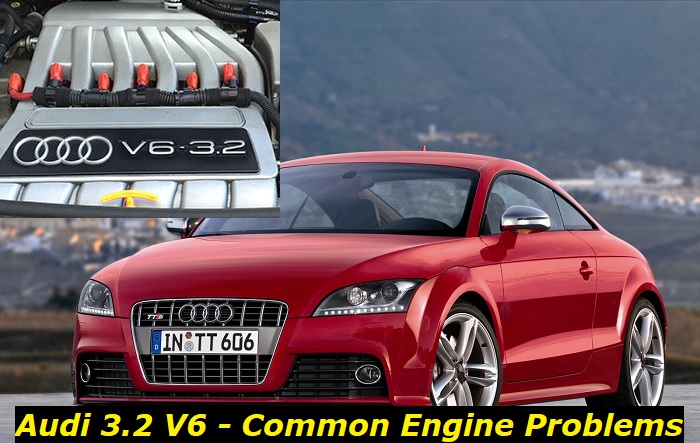From all indications, Audi 3.2 V6 Engine is a game changer and the go-between for Audi 2.0 and Audi S models. With a 3189cc displacement, this six-cylinder engine is a real jumbo. Its four valves per cylinder and Direct Injection System make sure, at 6500 rpm, it renders at 255 horsepower.
In addition, Direct Injection endows the engine with a top-notch fuel economy capability and makes it extraordinarily environmentally friendly, with minimal emission rate.

Before its introduction in 2004, Audi engines were riddled with problems. But this Volkswagen-inspired takes care of most of these problems, and so far, it has put in more than three decades of service to the automotive world without any callback.
Though Audi discontinued the production of the 3.2 FSI V6 engine in 2010, there are still many of these cars on the roads. It's, therefore, surprising that only scanty and incoherent information is available about this engine. Especially, there are no heads up for future owners.
This article changes that narration and outlines the pain points of the Audi 3.2 V6 Engine. Does its big size bring with it equally big issues?
Key features and my opinion about the engine
- Production years:2004-2010
- Average lifespan of 3.2L V6:160,000-190,000 miles
- Fuel supply type:direct injection
- Power range:255 hp
- Fuel efficiency:awful
- Engine block material:aluminum
- Engine reliability score:medium
- The most common problems:warped cylinder walls, piston issues causing oil consumption, timing chain problems, very intricate intake system, carbon buildup on intake valves.
What Are Audi 3.2 V6 Engine Problems?
This engine is definitely big, strong, and awesome, but it's not without problems. Whether these problems are big issues or not is better left to you to decide. However, let's explore some of its problems together.
1) Timing Chain Problem
The timing chain is instrumental in synchronizing the crankshaft and camshafts' movements. It ties these movements to that of the pistons and the opening and closing of the valves. Without this timed arrangement of movements, firing in the cylinders will be ineffective and useless.
In summary, your engine cannot run without a timing chain. The driver is probably done if the timing chain fails in the middle of nowhere. But that is not all; a bad timing chain can also cause a string of complications in the engine.
It is not hard to see why many owners of Audi 3.2 V6 engines consider this problem a big deal. Contrary to the 120,000 miles that Audi schedules for a timing chain, this engine's timing chain usually fails much sooner. And in critical incidents, the owners failed to notice in time, so complications set in. This always means a very expensive engine repair is required.
Changing the timing chain involves a complicated procedure to complicate this issue about the engine.
Symptoms of a Failing Timing Chain in Audi 3.2 V6 Engine:
- The engine may start misfiring.
- The engine does not start on the first attempt.
- You can hear a rattling sound while the engine is idle or starting up
- When you drain the engine oil, you can see metal shaves in the oil collected.
2) Weak Chain Tensioner Problem
The chain tensioner works closely with the timing chain. By design, the tensioner holds the chain in place so that it remains tightly wound around the pulleys and gears at all times. A failed tensioner automatically results in a loose timing chain.
A loose timing chain can easily jump out and cause the pistons to break or bend.
Symptoms of Weak Chain Tensioner in Audi 3.2 V6 Engine:
- You can hear the engine rattling irritatingly
- The car's speed does not match the engine torque and RMP.
- The Check Engine Light may come on.
- It may become increasingly more difficult to start the engine.
3) Excessive Oil Consumption Problem
Going by the manual, your Audi 3.2 V6 engine needs just 1 quart of oil per 1000 miles. However, some owners of this engine are complaining about its more than negligible excessive oil consumption. In some especially bad cases, oil burning to the tune of 83 quarts per 1000 - 1200 miles during the winter, and the same quantity burnt in just 700 miles during the summer, had been reported. You can easily smell this from the fumes.
Well, this problem is likely part of the aftermath of some design problems (seeming or real) in the oil rings and the oil ring holes in the pistons. For some inexplicable reasons, the holes in the piston block too easily and quickly.
Therefore, wiping oil off the cylinder walls becomes impossible. The excess oil on the cylinder walls escapes into the combustion chamber, where it gets burnt. Some of this extra oil may end up in the oil pan. Either way, the same result ensues: engine oil shorts' untimely.'
Symptoms of High Oil Consumption in Audi 3.2 V6 Engine:
- When you start the car having let it sit over the night, or after it's been parked long, the engine emits non-stopping blue smoke.
- The engine oil goes down every day, even hours after topping it.
- The engine is overheating and making a grounding sound.
- You can smell oil in the smoke from the exhaust pipe.
4) Excessive Carbon Buildup Problem
This is a direct consequence of this engine being based on the Direct Injection System. Both the valves and the injectors can serve as carbon depots. It results from the fact that fuel does not pass over them (the intake tracts and the intake valves do not enjoy the luxury of fuel passing through and cleaning) and cleanse them in the process.
Findings show that the carbon gathers from three points: valve overlap, worn valve oil seals, and crankcase ventilation vapors. It may also be a result of using low-grade fuel.
Audi 3.2 V6 engine is 'notorious' for this problem. Though several preventive measures have been suggested, none seems to work.
Symptoms of Excessive Carbon Buildup in Audi 3.2 V6 Engine:
- You can see black smoke coming out from the exhaust system.
- The engine's acceleration performance decreases.
- The engine sounds croaky and rough while idling and hard to start.
- The engine may lose its fuel economy capability.
5) Oil Leak Problems
Audi 3.2 V6 engine, like every other engine, is not supposed to leak any liquid - oil, gas, or coolant. A leakage, whatsoever it may be, means something amiss with your car. That is why your engine has many gaskets - to keep the oil where it should be. Unfortunately, your Audi 3.2 V6 engine might be susceptible to oil leak problems.
One of these oil leak problems is valve cover oil leakage which is a common problem with this engine. The causes can vary from car to car. However, it is generally from the wear and tear that comes with increases in mileage. Temperature changes, from extremely hot to cold, can crack or crook the valve cover, causing oil leakage.
Likewise, the gasket seal in the valve cover can wear off or erode over time. The immediate effect of a disintegrated gasket here is that a space is created between the cylinder top and the valve cover.
The crankcase breather cover gasket is another likely point of an oil leak. Like with the valve cover gasket, once the crankcase breather loses its gasket, an easy passage is created for oil to leak out of the engine.
Other likely sources of oil leaks in your engine are a bad oil filter, a punctured or cracked oil pan, and a worn crankshaft.
An oil leak would not have been a major problem if it had no adverse effect on the engine. But the reality is that it can lead to more serious damage to the engine. Your engine can lose too much oil to the extent that there is not enough to lubricate the cylinder walls. This situation can get the pistons stuck in the cylinder and your engine stalled.
Symptoms of Oil Leak in Audi 3.2 V6 Engine:
- The car leaves a puddle of oil behind when it is driven off after it's been parked for a while.
- Oil sprinkles wildly when you crank the engine.
- Oil stains cover a large part of the engine.
- Oil drips from the oil pan.
6) Design Problem
Virtually all issues associated with this engine emanate from this area. Often, it's either a less durable material used in building some parts, or the positioning of some features is poor.
For instance, by design, you cannot do certain repairs (that ordinarily should be simple procedures) on this engine without first having to disconnect it from the transmission or remove it entirely. That's a huge minus as it complicates maintenance.
The positioning of the timing chain drives is a good case in point. These drives are at the back of the engine in such a tight corner that accessibility is a problem. To do any maintenance on this part, you must disconnect the whole engine from the transmission and bring it out to gain easy access. But that's not all; you need to remove the flywheel too.
Any attempt to do head removal work on the engine will, unfortunately, suffer the same fate.
Final Thoughts
A confirmed huge luxury engine, Audi 3.2 V6 engine remains a force to reckon with in the automotive world years after Audi axed its production. Though we found different issues with different degrees of seriousness with the engine, we conclude that the engine is awesome. Many owners still believe these problems only surface after the car must have served you meritoriously.
Besides, all of these problems are covered by a warranty. And where the warranty has expired, you can get the engine repaired at very affordable prices. And, for a few of these problems, you can avoid them by doing constant and quality maintenance.
About the authors
The CarAraC research team is composed of seasoned auto mechanics and automotive industry professionals, including individuals with advanced degrees and certifications in their field. Our team members boast prestigious credentials, reflecting their extensive knowledge and skills. These qualifications include: IMI: Institute of the Motor Industry, ASE-Certified Master Automobile Technicians; Coventry University, Graduate of MA in Automotive Journalism; Politecnico di Torino, Italy, MS Automotive Engineering; Ss. Cyril and Methodius University in Skopje, Mechanical University in Skopje; TOC Automotive College; DHA Suffa University, Department of Mechanical Engineering






Add comment